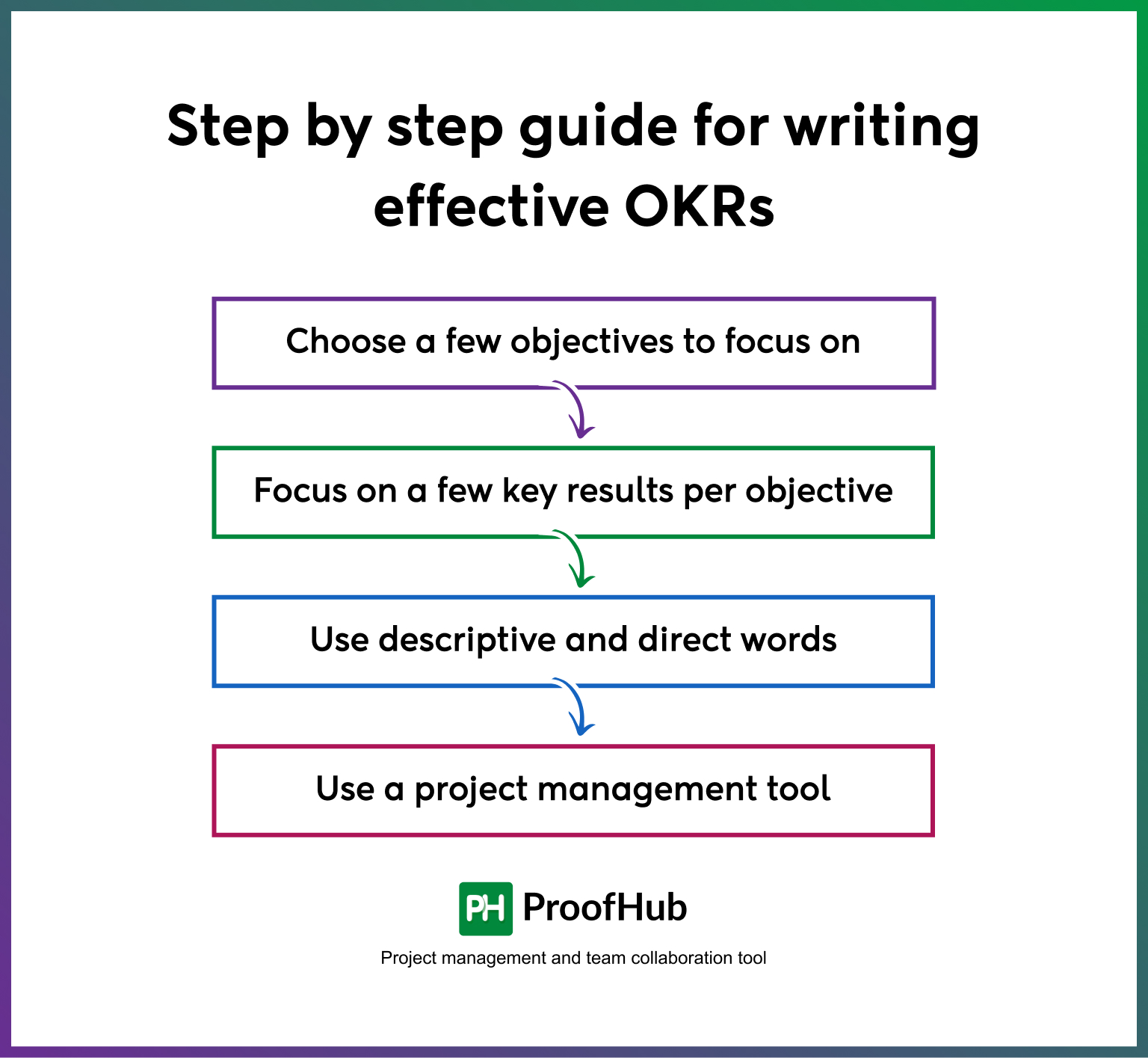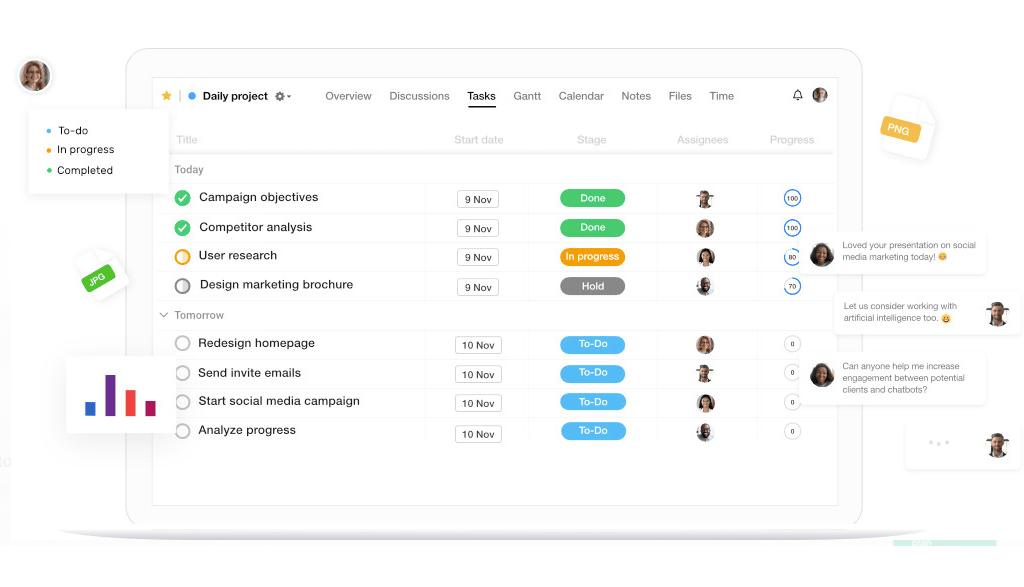OKRs. You know them. You love them. You hate them.
But without a doubt, you’re familiar with their ubiquitous nature in the startup world.
As described by John Doerr, a well-known venture capitalist and early Google investor, OKRs or Objectives and Key Results are used to set company direction as well as measure performance against established goals/purposes.
The OKR is a performance management mechanism that aligns the personal and professional goals of each employee of an organization.
The goal of this blog post is to show you how to set OKRs that are effective.
What is OKR and why is it so popular?
OKR stands for Objectives and Key Results. Go ahead, try saying that five times fast. Actually, don’t bother; it’s easier if you just say OKRs.
In case you’ve never encountered this term before, here’s the gist: An OKR is a measurement tool used by companies to set goals and track progress over time.
Each year or quarter that passes has its own overall objective (e.g., “Reach $1 million in revenue by Q3”) and individual key results (e.g., “Increase sales leads by 20%”).
Create project roadmap, share ideas with your team and reach goals on time with ProofHub.
>Step by step guide for writing effective OKRs

Choose a few objectives to focus on
At this point you’ve already done some research and thinking about your company and its objectives, but it’s still a good idea to make sure that your team’s goals are specific enough. The whole point of OKRs is to help people focus their energy on particular tasks—so if an objective isn’t well-defined enough, then employees may not know how to take action.
For example, consider a hypothetical scenario where one executive sets the following goal:
“Increase quarterly revenue by 5 percent.”
While this objective seems straightforward enough at first blush (we all know what increasing revenue means), here are three problems with this type of objective:
It doesn’t provide a clear end-state for the employee who’s responsible for achieving it; instead, it only provides direction as far as how much money needs to be brought in each quarter (i.e., “by 5 percent”).
How do I know when I’m done? How long do I have? Where do I start? What will success look like? These questions can all be answered with additional detail around #2…
It doesn’t state how they’ll accomplish said increase; i.e., what’s the plan and timeline? There needs to be more clarity on these points before anyone can begin working toward them effectively—and remember: business is all about execution! You want everyone on board with whatever strategy is decided upon so there aren’t any missed opportunities because someone wasn’t paying attention during meetings or forgot about something important later down the road.”
Focus on a few key results per objective.
So, how many key results should you choose per objective?
The answer is: it depends. While the general rule of thumb is that 3-5 key results are a good number to aim for, there are some things you can do to make sure you’re picking the right number of key results for your objectives.
The first thing to consider is whether or not too many or too few key results will be distracting or overwhelming in terms of tracking them.
If too many KPIs are assigned to an objective and employees aren’t able to keep up with all of their tasks, then it could slow them down and cause them stress.
On the other hand, if employees only have one or two things on their plate at a time, they may feel like they’re not being ambitious enough in their work or have little room for growth opportunities within that specific project/company direction.
Use descriptive and direct words
You should use distinct and basic terminology. Don’t confuse your team with jargon, or they won’t understand what you mean. Instead, use simple language that everyone will understand.
Define acronyms if they aren’t well-known or if they’re used frequently in your organization.
For example: “We need to increase our Q1 sales revenue.”
This could be confusing for someone who doesn’t know what Q1 is—it’s a quarter of the year (the first quarter).
Instead, you could say: “In the first quarter of 2018 we want to increase our sales revenue by 20%.”
The acronym becomes clear when it’s defined at the beginning of the sentence rather than mid-sentence as in this case where it can take time for readers to figure out what Q1 means.
Avoid using passive voice too much because this makes sentences hard to follow and understand; instead choose active voice when possible!
Use a project management tool
A project management tool can help you get things done by providing you with a list of all the tasks that need to be done, along with their deadlines and other relevant information.
The right project management tools can also help you in goal setting by allowing users to set goals for themselves or their teams, give them deadlines and monitor progress towards those goals.
The best part about using such a system is that it allows users to easily track their performance against these goals over time so they know whether they are making sufficient progress towards achieving them or not.
ProofHub – One tool that has all the ingredients to help you achieve your goals.

You can get project management software for the team or for personal goal setting with ProofHub. It is a very simple, intuitive and easy to use tool that won’t take you much effort to master.
This can be especially helpful if users want to use this data as part of their annual performance review process or if they want their employees’ managers (or even themselves!)
ProofHub is an online project management software that allows you to create projects, assign tasks within those projects, and track the progress of those tasks. It also features an integrated calendar that syncs with your Google Calendar so that everyone in your team can see everyone else’s availability at a glance.
You can use ProofHub for OKRs by creating a new project and assigning each person on your team an individual task within that project. Once they’ve completed their task(s), they’ll be able to submit them through the app so that everyone knows when something has been accomplished—and if it hasn’t been completed yet!
In this way, ProofHub allows you to see the progress being made on each task so that you can keep tabs on the overall progress of the project as well as know who needs help completing certain tasks (or even if someone forgot about it altogether!).
With real-time, live reporting, you’ll have all the data you need to Bring Your Goals to Life! Try ProofHub now.
>A simple formula for writing a good OKR
The formula for a good OKR is O = KR1 + KR2 + KR3.
Here’s what that means:
The Objective needs to be ambitious, but it should also be realistic. It can’t be something like “world peace” or “complete every achievement in Forza 7.”
That would be nice if you were the president of the United States or an Xbox One owner (respectively), but it isn’t likely to happen with your team within a year’s time frame.
Also, keep in mind that there is no expectation on how big the objective should be; just make sure it is measurable and clear enough so you don’t have any confusion about what success looks like when you achieve each objective throughout your quarter/year cycle.
An objective needs to be an achievement rather than merely an activity or deliverable (like building feature X).
If your goal is simply “build X feature,” then there’s nothing really at stake during this process other than getting X feature built—which may not always align with what makes sense for growing your company over time–and without any consequences attached if someone doesn’t get X built on schedule or even at all!
>How do you write a good Objective in OKR?
For the most part, an objective should be clear and concise. That’s it. You don’t need to overthink this too much.
A good Objective is measurable.
That means you can put a number or a percentage next to it and say “We did X% of what was expected.”
This is great for tracking progress on your objectives and for measuring success against them (or failure).
An objective should be smart, not stupid.
An objective like “sell more stuff” isn’t very smart because it doesn’t tell us how many units of whatever needs selling or how to achieve said sales growth—it just tells us that we need more sales in general!
In contrast, an objective like “increase revenue by 20% over the next three months” is smarter because there’s some idea of how much money needs making and how we’re going about doing so (i.e., selling more products). It also gives us something concretely actionable: if our team members don’t meet their individual goals related to increasing revenue by 20%, then they’ll likely lose their jobs as punishment!
An effective objective should be realistic—but not too realistic! This means that while achieving something such as “making all our customers happy” might not actually happen (because people are inherently unhappy), it would still be good enough if each employee did their best job at making all customers equally satisfied with their service levels throughout any given week/month/year…and then got fired if they didn’t do that well enough consistently enough across different time periods during which they worked here together as part of one big happy family! Wowza!
An inspiring Objective will motivate everyone involved with using it; otherwise it won’t really inspire anyone at all.”
>How do you write a good Key Result in OKR?
In the previous section, we looked at how you can be a good leader and write OKRs for your team. But what about when it comes to writing your own goals?
OKRs are all about setting measurable KPIs (key performance indicators) for yourself and your team. If you’re not sure how to do that, let me give you an example:
- What are we trying to achieve? For example, “I want to reduce customer churn by 10% in Q3 of this year.”
- How will we know if we did it? “We will measure our customer churn rate quarterly and track whether it has decreased by 10%.”
This formula is simple but has proven its effectiveness time and time again because it forces leaders to think about their goals before they start working on them – making sure they keep the end result in mind while planning out their actionable steps towards achieving them.
>How do you create an Initiative for an OKR?
This is where you want to start thinking about the “Why” of your initiative.
If you’re a salesperson, for example, and you set a goal for yourself that’s focused on increasing sales revenue by $1 million in three months’ time, what are the things that will help make that happen? Maybe it’s expanding into new territories or changing up a marketing strategy. Whatever it is, this is where things get interesting.
Ideally, each initiative should have its own goal or targets so that employees know what they need to accomplish in order for their initiative to be successful. For example: “Expand into new territories by adding 10 new accounts within two weeks of launch” or “Change up our marketing strategy by having 10% more people view our YouTube channel by next Friday.”
>How do you create weekly plans for an OKR?
So you’re ready to start using OKRs (Objectives and Key Results), but how do you actually create a set of weekly plans?
We’ve got you covered. Here are three steps to follow:
- Determine what your OKRs are going to be for the quarter. If you’re just starting out with OKRs, make sure to read up on understanding them first.
- Calculate each goal’s weekly target percentage (WTP). This is the amount of effort that should be devoted to each goal every week. Once you have this number for each goal, add them together and divide by 4, since there are 4 quarters in a year. This will be the total amount of effort required for reaching your goals for each quarter (and thus how much time should be allocated per week).
- Create a weekly plan for each objective based on its WTP, prioritizing those with the highest level of urgency (urgency is measured by multiplying importance by estimated time).
>Before and after: turning a so-so OKR into a good one
Now that you know what OKRs are, let’s take a look at how you can use them to your advantage.
An important part of any OKR framework is the initial goal setting. Before you even begin writing your first set of goals, it’s important to consider why the company has chosen this system and whether or not it will be valuable for you personally. It’s also important to check with your manager if they have any preferences or expectations regarding their team’s alignment around goals in general. In addition, taking time before beginning on any project can help ensure that everyone is on board and understands how they fit into the larger picture of organizational priorities as well as individual responsibilities within said priorities (like yours).
It’s recommended that each team member write their own personal goals before sharing them with others so that everyone knows what each person cares about most—and what areas may require more focus than others if necessary changes need to be made later on down the road due to unforeseen circumstances beyond our control such as budget constraints or unforeseen personnel changes within our respective teams/departments.”
>OKRs vs task management
If you’re new to OKRs, it can be helpful to understand the difference between OKRs and task management.
In short, an OKR is not a list of tasks. It’s a way of focusing on what’s most important.
Tasks are important for getting things done and meeting deadlines, but they’re not always the best way to make progress toward ambitious goals. What if there was another way?
The concept of “OKRing” has been around since 2007 when John Doerr (VC at Kleiner Perkins) wrote up their approach in Fortune magazine: “We set stretch goals and measure our results against them every quarter by creating balanced scorecards that guide our business decisions.”
Set your priorities straight and give yourself one less thing to worry about. Try ProofHub now.
>OKRs vs KPIs
OKRs and KPIs are similar in that they’re both used to track how well you’re achieving your goals. However, the two words have different meanings.
KPIs (key performance indicators) are metrics that tell you if you’re on track to achieve a goal.
If a KPI is green, it means things are going well; if it’s red or yellow, something needs to change to get back on track.
In other words, KPIs measure whether a goal has been met–they’re not aspirational like OKRs.
OKRs (objectives and key results) are used by companies like Google, LinkedIn, SpaceX and many others for setting goals for employees at all levels of the company.
OKRs can be difficult for teams new to them because they take some time getting used to defining what an objective really is: an objective should describe why we want something rather than how we’ll get there or what happens if we don’t get there (these pieces of data belong in key results).
When creating your own custom objective list using this toolkit template provided by Google Ventures partner Jake Knapp (and most importantly sharing them with everyone), make sure your objectives aren’t just checking off boxes on a checklist—they need concretely show how each employee will contribute toward those metrics so everyone knows what they’re supposed do everyday when they walk into work!
Wrap Up
As a final note, we’d encourage you to make sure your OKRs are SMART.
In other words, be specific about what you want to accomplish with each one of your goals (the WHAT), the measurable results and how you’ll know when it’s accomplished (the HOW), and what kind of deadline or due date to give it (the WHEN).
By making your OKRs SMART, you can increase the likelihood that each of these goals will be achieved by putting them in a timeline that works for you and letting yourself know when each goal can be considered complete.
Next time you’re setting goals, we hope that these tips will help you prioritize your tasks and make your OKRs even more effective. And if you find that a lot of your goals are falling by the wayside, read on for another few helpful hints for sticking to your OKRs.
And now: go set some goals!


